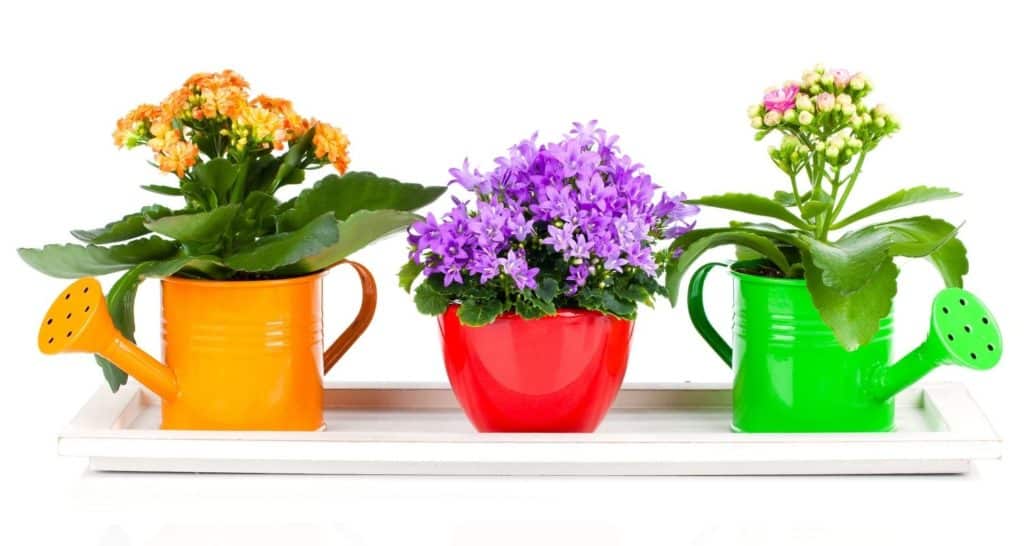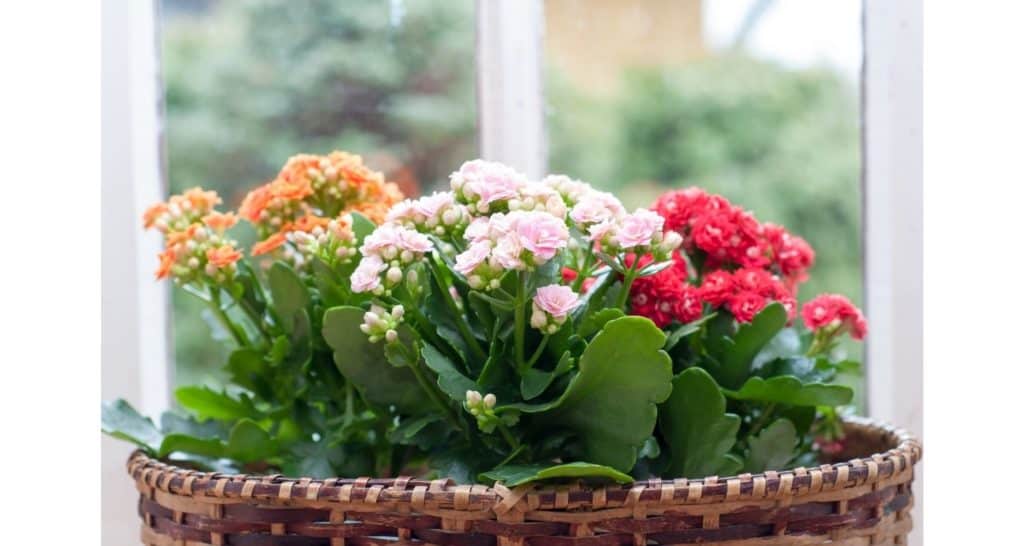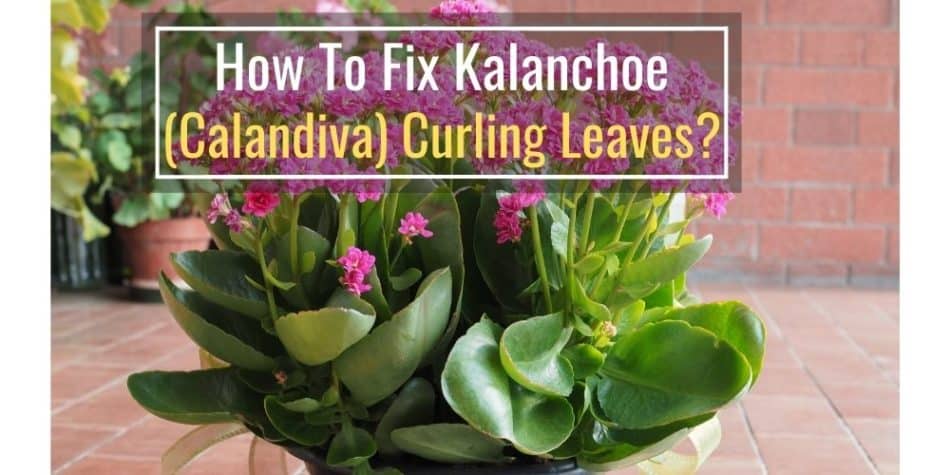Kalanchoes, or sometimes called Florist Kalanchoes, Kalanchoe Blossfeldiana, or Calandivas, are a common flowering succulent that have bright beautiful flowers that contrast against the dark green leaves.
These flowering succulents are popular since you can find them at nurseries, garden centers, and even some grocery stores. Not to mention succulents are a hardier type of plant that are more drought tolerant in case you forget to water your plant for a few days.
Although succulents and Kalanchoes are drought resistant which make them beginner friendly – they still require some upkeep otherwise the plant will show signs of stress.
An early sign of stress with Kalanchoes is curling leaves which usually is an indicator that something is wrong with the plant.
So how do we fix curling leaves on a Kalanchoe or Calandivas?
Kalanchoes are naturally found in Madagascar and other tropical regions so they prefer warm, humid environments with lots of indirect sunlight. Common reasons for curling leaves on a Kalanchoes are lack of water, low humidity, drafts or air vents, and direct sunlight. These common issues can be resolved by watering the plant more, using a pebble tray to increase humidity, and placing the plant in an area with bright indirect sunlight.
Thankfully, Kalanchoes, also known as Calandivas, are hardy plants that can bounce back when properly cared for.

Let’s cover the most common issues and their solutions so you can diagnose and help your Kalanchoe return to normal.
Common Reasons For Kalanchoe’s Leaves To Curl
Knowing that Kalanchoes are naturally found in tropical climates can help us understand and resolve most common reasons for curling leaves.
Typically curling leaves are a sign that the leaves themselves are not receiving enough moisture or water from the environment. However, do not start watering the plant everyday as overwatering can also cause curling leaves due to root rot.
So lets dive into the most common reasons for curling leaves.
1. Underwatering Can Cause Kalanchoe’s Leaves To Curl
One of the most common reasons for curling leaves on the Kalanchoe is from underwatering.
Underwatering will cause stress on the plant, sometimes referred to as water stress, which is visibly shown by curling leaves.
Kalanchoes are native to tropical regions which means this plant prefers a wet and humid environment. So underwatering will lead to dryness which this plant does not like.
Watering the plant more frequently and misting the leaves will encourage the leaves to uncurl over time.
When To Water Kalanchoes
Follow these steps in order to determine when to water a Kalanchoe:
- Insert your index finger into the soil 1 to 2 inches deep
- Feel for moisture
- Water if the soil is dry
- Do not water if the soil is wet or moist
This watering schedule and moisture detection method also works for most other tropical plants.
The best part of this watering method is that the soil will dry out faster in hotter months which will lead you to water the plant more often. Whereas the plant may not need as many waterings during the winter months since the soil will remain moist longer.
Remember tropical plants are naturally found in humid environments where there’s lots of rainfall. So try to recreate this environment as much as possible in your home.
2. Overwatering Can Cause Kalanchoe’s Leaves To Curl
Overwatering can cause the soil to become soggy which can cause the Kalanchoe’s leaves to curl.
Surprisingly, overwatering can cause leaves to curl.
Overwatering, poor-draining soil, and/or a pot that does not have a drainage hole will all lead to soggy soil. Soggy soil for any indoor plant can become a major issue overtime.
Soggy or overly wet soil will eventually lead to root rot which can be fatal to a plant. By the time the leaves of a plant start curling from overwatering, the damage to the roots will usually be extensive.
Since the roots are rotting and are unable to draw in moisture – the plant is actually drying out because it is unable to drink as much water as it needs. So overwatering is a common beginner mistake when the plants leaves start to curl.
Once root rot develops, it can only be fixed by removing the rotten part of the plant. After the rotted roots have been removed the remaining plant can be repotted with indoor potting soil that allows for excess water to drain.
Stick to the following water schedule in order to prevent root rot from developing in the first place.
When To Water Kalanchoes
Follow these steps in order to determine when to water a Kalanchoe:
- Insert your index finger into the soil 1 to 2 inches deep
- Feel for moisture
- Water if the soil is dry
- Do not water if the soil is wet or moist
This watering schedule and moisture detection method also works for most other tropical plants.
The best part of this watering method is that the soil will dry out faster in hotter months which will lead you to water the plant more often. Whereas the plant may not need as many waterings during the winter months since the soil will remain moist longer.
Remember tropical plants are naturally found in humid environments where there’s lots of rainfall. So try to recreate this environment as much as possible in your home.
3. Too Much Direct Sunlight Will Cause Kalanchoe’s Leaves To Curl
Kalanchoes are native to tropical climates. Given their relatively short size in a tropical region – these tiny flowering succulents are commonly found under the canopy of larger trees.
Kalanchoes prefer a warm, humid environment that has plenty of bright, indirect sunlight. Similar to what a Kalanchoe would receive when growing underneath the jungle’s canopy.
Move The Kalanchoe To A Different Location
If the Kalanchoe is located beneath a window that receives a lot of direct sunlight then the direct exposure may be too much. Excess direct sunlight will damage the plant and cause the leaves to curl.

By curling the leaves, the plant is trying to reduce the surface area exposed to sunlight.
The best solution is to place the Kalanchoe away from the window so it can still receive indirect sunlight. After a few days the leaves will uncurl if the direct sunlight was causing the leaves to curl.
4. Low Humidity Can Cause Kalanchoe’s Leaves To Curl
Kalanchoes thrive in humid environments. Unfortunately, most indoor spaces are rarely humid especially during colder months when the heater is turned on.
Not to mention air conditioners typically lower the room’s humidity so the plant will still be in less than ideal conditions during summer months.
Provide More Humidity To The Kalanchoe
Make sure to move the plant if the Kalanchoe is in a drafty walk way or near a heater vent. The plant will curl its leaves when continually being hit with warm or dry air.
Another option to get the Kalanchoe’s leaves to curl is to mist the leaves daily or place a humidifier near the plant. The humid air will uncurl the leaves over time.
5. Too Much Fertilizer Can Cause Kalanchoe’s Leaves To Curl
Klanchoes do not need a lot of fertilizer and most indoor potting soil comes with a fair amount of nutrients. If you have been heavy-handed on the fertilizer then the leaves will curl.
Curling leaves can be a sign of too much fertilizer as the minerals will build up and affect the pH of the soil. The plant will not be able to absorb nutrients and water due to all the minerals in the soil which causes the leaves to curl.
Another symptom of over fertilizing is that the plant’s leaves may start spotting or have other discoloration along the edges or the veins. This discoloration is a sign that the plant is unable to absorb the nutrients it needs due to overfertilization.
Repot The Plant If There Is Too Much Fertilizer
The best solution to having a plant growing in a soil that has too much fertilizer is to simply repot the plant with fresh indoor potting soil.
If a plant is already showing signs of stress from too much fertilizer then it will not do well if it remains in the same soil.
Thankfully most indoor potting mixes contain a fair amount of nutrients that the plant will use to grow. So a repotted plant will not need to be fertilized for at least 6 months.
6. Pests Can Cause Kalanchoe’s Leaves To Curl
Dust, poor air circulation, and dehydration make an ideal breeding ground for pests. Common pests that infest Kalanchoes are:
- Mealybugs: These pests attach their egg sacs to the leaves and stems. Once hatched and grown into adult bugs, they spread to other leaves, stems, and in the soil.
- Whitefly: This white-colored insect is found on the base of the leaf. It sucks nutrients from the leaves and excretes a sugary substance that becomes moldy. As the mold grows, it covers the leaves and blocks light absorption.
- Aphids: The palm aphid sucks the sap from the leaves and stem of the Kalanchoe. Like the whitefly, aphids excrete a sugary substance on the leaves that becomes moldy and blocks sunlight.
- Red spider mites: These insects form webbings and make the leaves look dusty and discolored. A light infestation can be treated. However, heavy infestation may mean getting rid of the plant to prevent any spread to other plants.
Common treatment for most indoor pests is to create a warm soapy water spray that can be applied directly onto the bugs and plants. This homemade insecticidal spray is safe to use on plants and safe to spray around kids and plants.
View this guide on how to make your own homemade insecticidal soapy spray.
Just make sure to use castile soap instead of any scented soaps or dish soaps. Most scented or dish soaps are actually a detergent which will damage the plant’s leaves.
7. Tap Water Can Cause Kalanchoe’s Leaves To Curl
It is common to use tap water when watering indoor house plants. Unfortunately, tap water typically contains salts and other minerals that cause a buildup over time in the soil.
Excessive salt and mineral build-up alters the soil pH and inhibits Kalanchoes from absorbing nutrients such as nitrogen.
Similar to over fertilizing the soil, excessive salt and mineral build up will cause the plant’s leaves to curl and discolor.
The best solution is to repot the plant with new soil and use distilled water.
You can still use tap water as long as you let the water sit overnight or for an hour so the salts and minerals can sink to the bottom of the water pail. Just make sure to not use the water at the bottom of the water pail since that’s where all the excess salts and minerals will be.
Final Thoughts
The Kalanchoe is a great houseplant for anyone who wants to liven up an indoor space. Kalanchoes are also a great beginner houseplant since they are a relatively easy and low maintenance plant.
However, a Kalanchoe still needs the right growing conditions otherwise it will start showing signs of stress. Curling leaves are an early indicator of stress.
Thankfully, Kalanchoes are hardy plants that will bounce back when given the right growing conditions. Just remember they they are naturally found in humid, warm rainforests.
Once given the right growing conditions, your Kalanchoe will liven up your indoor space for many years to come.

